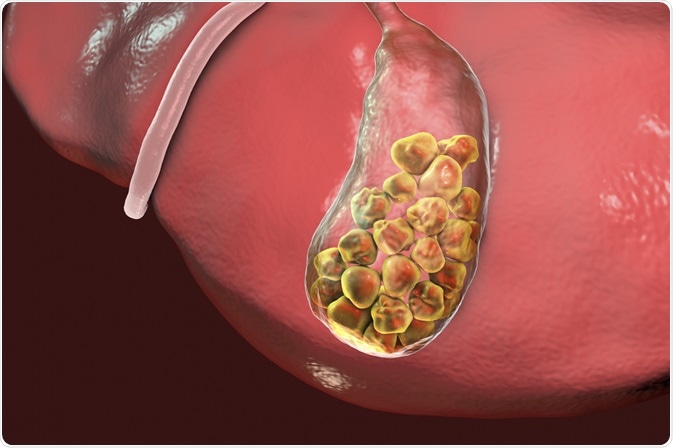Recent evidence has uncovered that immune cells are responsible for driving gallstone formation.

Image Credit: Kateryna Kon/Shutterstock.com
Back in September 2019, a team of researchers in Germany published their findings in the journal, Immunity, describing how sticky meshworks DNA and protein, known as neutrophils, bind calcium together with crystals of cholesterol, resulting in gallstone formation.
By inhibiting the production of these neutrophil extracellular traps (NETs) it was observed that gallstone formation in mice decreased.
Their findings may help to develop future treatments and prevention methods for gallstones by targeting neutrophils and NET formation.
Neutrophils are part of the body’s immune system and have long been thought of as the first line of defense against invading pathogens.
Studies have shown that neutrophil extracellular traps (NETs) tangle with and kill these pathogens. However, these NETs have now been shown to have another, less helpful role in the formation of gall stones.
A new treatment for gallstones?
Ranging from the size of a grain of sand to the size of a golf ball, gallstones can be incredibly painful to those suffering from them, and in some cases also cause nausea and vomiting. Gallstones are the primary reason worldwide why people make a trip to the hospital.
Removal of gallstones often involves extensive procedures, sometimes over months, to break the gallstones down into smaller pieces, and surgical removal of the gallbladder is one of the most common operations performed in the US.
There is a clear need for new effective treatment and prevention techniques for gallstones detection and removal.
One major barrier to developing these new methods, however, is that the exact mechanisms underlying gallstone formation had remained elusive.
While scientists have known for several decades that cholesterol and calcium salts play a major role in gallstone formation, it was not clear how the cholesterol and calcium salts adhered together, forming gallstones.
In a lab at Universitätsklinikum Erlangen, Germany, a team of researchers had been investigating biliary sludge when they witnessed large aggregates of DNA along with the activity of neutrophil elastase.
Also, the team observed DNA patches and high levels of neutrophil elastase activity on the surfaces of human gallstones.
These molecules are indicative of NETs, which are known for fighting infection but also for their role in inflammatory disorders.
The researchers then observed the release of DNA from cultures of cholesterol crystals with human neutrophils to distinguish have NET formation was initiated. Also, the researchers spun human gallstones both in the presence and the absence of neutrophil.
It was observed that, when neutrophils were present, DNA patches and neutrophil elastase quickly collected on the surface of the gallstones.
Further testing revealed that NETs were responsible for the binding of cholesterol and calcium crystals in the biliary fluid, resulting in the formation of gallstones. Also, larger stones were seen to be the result of DNA wrapping around the crystals, pulling them together.
Experiments
Given these promising results, scientists set up more experiments to explore the role of NETs and neutrophils further. The team found that the mice with genetic defects that prevented the formation of NETs developed fewer and smaller gallstones.
They also found that mice with few neutrophils grew smaller gallstones. Further to this, some mice were fed on a diet that had the effect of inhibiting protein-arginine deiminase 4 (involved in NET formation), or metoprolol (involved in neutrophil migration).
In mice on both of these diets, additional growth of pre-existing gallstones was prevented.
The team concluded that neutrophils and NETs play a key role in gallstone formation and that the focus should now be shifted on therapeutic methods that target NET formation.
It is possible that treatments targeting protein-arginine deiminase 4 or metoprolol could be developed as a non-invasive method that reduces the need for surgery.
However, human studies will be required to confirm these findings before potential therapies can be developed.
Sources:
- Reinwald, C., Schauer, C., Csepregi, J., Kienhöfer, D., Weidner, D., Malissen, M., Mocsai, A., Schett, G., Herrmann, M. and Hoffmann, M. (2016). Reply to "Neutrophils are not required for resolution of acute gouty arthritis in mice." Nature Medicine, 22(12), pp.1384-1386. https://www.ncbi.nlm.nih.gov/pubmed/27923022?dopt=Abstract
- Shaffer, E. (2005). Epidemiology and risk factors for gallstone disease: Has the paradigm changed in the 21st century?. Current Gastroenterology Reports, 7(2), pp.132-140. https://www.ncbi.nlm.nih.gov/pubmed/15802102?dopt=Abstract
- Muñoz, L., Boeltz, S., Bilyy, R., Schauer, C., Mahajan, A., Widulin, N., Grüneboom, A., Herrmann, I., Boada, E., Rauh, M., Krenn, V., Biermann, M., Podolska, M., Hahn, J., Knopf, J., Maueröder, C., Paryzhak, S., Dumych, T., Zhao, Y., Neurath, M., Hoffmann, M., Fuchs, T., Leppkes, M., Schett, G. and Herrmann, M. (2019). Neutrophil Extracellular Traps Initiate Gallstone Formation. Immunity, 51(3), pp.443-450.e4. https://www.cell.com/immunity/fulltext/S1074-7613(19)30318-8
Further Reading
Last Updated: Feb 24, 2020